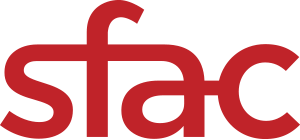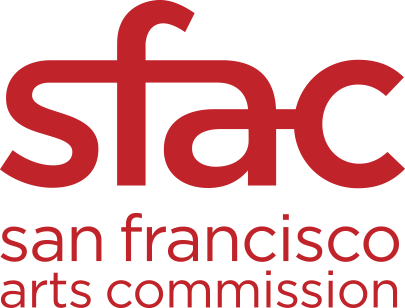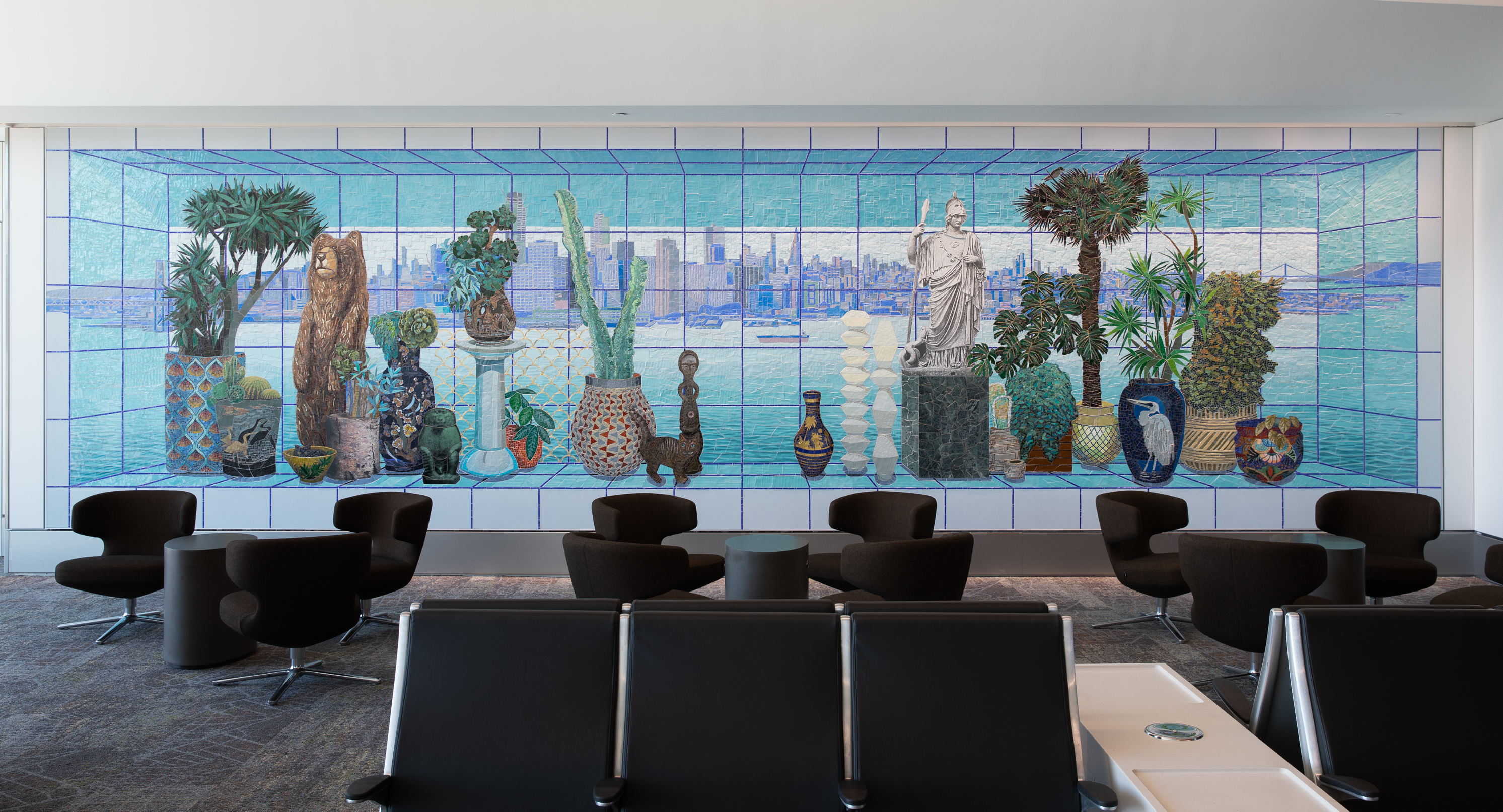San Francisco’s earliest art policies date back to the establishment of the Arts Commission under the 1932 San Francisco Charter. The Charter gave the Arts Commission jurisdiction over all of the art belonging to the City and charged the Agency with the preservation and care of artwork in the Civic Art Collection.
Permanent Public Art
Years later in 1969, the Art Enrichment Ordinance (the 2%-for-art program) was enacted to provide a guaranteed funding mechanism for the acquisition of artwork for new public facilities and civic spaces. The Ordinance ensures that two percent of the gross construction cost of civic buildings, transportation improvement projects, new parks, and other above-ground structures such as bridges, be allocated for public art.
San Francisco also has a “1%-for-art program” that requires that large projects in the Downtown and nearby neighborhoods provide public art that equals at least 1% of the total construction cost. This program was established by the 1985 Downtown Plan and is governed by Section 429 of the Planning Code and is overseen by the San Francisco Planning Department. Since May 2012, some projects may choose to dedicate a portion of their 1% art requirement to the City’s Public Art Trust, which can be used for a variety of purposes including restoration of artworks in the Civic Art Collection, nonprofit capital projects and temporary public art programming. To learn more about the Trust and its requirements, please see the Public Art Trust Fact Sheet.
The Civic Art Collection is comprised of over 4,000 objects that include: historic monuments, memorials, gifts to the city, annual art festival purchases made from 1946 to 1986 and more recently, the hundreds of contemporary artworks commissioned through the City's 2%-for-art program. Valued in excess of $90 million dollars, this extremely diverse collection represents many significant art movements executed by artists of national and international renown and includes the work of generations of San Francisco artists. Consistent with the Commission’s mission to integrate artwork into the fabric of daily life in the City, the artwork is found in public facilities and spaces of every description such as hospitals, libraries, courthouses, parks, playgrounds, libraries, along the waterfront, in major plazas such as Union Square, Moscone Convention Center, the airport and the zoo. Search the collection!
City agencies have the option to borrow works from the Civic Art Collection for their department offices. Learn more about our Loan Program. [Please note, the art loan program is currently on hold until further notice. We are not accepting new requests at this time.]
Help preserve the Civic Art Collection for generations to come! Established in 2010, ArtCare is a nonprofit partner dedicated to building a bridge between local government and the private sector to help protect and preserve civic monuments and sculptures. Learn more.
Temporary Public Art and Murals
The Arts Commission must approve the temporary or permanent installation of any work of art on City and County of San Francisco property, or any proposal funded in whole or in part by City funds (regardless of its proposed location.) This includes proposals initiated or funded by other City departments, or by outside sponsors, such as individual artists, organizations, or commercial enterprises. Please review our Guidelines for Temporary Public Art and our FAQs.
For more information about how to create a mural in San Francisco, visit the MURAL section of our website.
The StreetSmARTS program is a partnership between the San Francisco Arts Commission and Public Works that pairs artists with private property owners who have received Notices of Violation for the removal of graffiti on their buildings. Instead of repeatedly having to remove graffiti or pay associated fines, private property owners may opt into the StreetSmARTS program and have a mural painted on their property. StreetSmARTS murals deter ongoing vandalism that many private property owners face, while also beautifying neighborhoods. Learn more.
- Gift Policy
- Public Art Commission Policies
- Public Art Guidelines
- Public Art Trust Guidelines
- Temporary Public Art Guidelines
- Mural Design Approval Guidelines
National Public Art Resources
Americans for the Arts’ Public Art Network (PAN) develops professional services for the broad array of individuals and organizations engaged in the expanding field of public art. More than 350 public art programs exist in the United States at the state, local and national level. PAN connects the field by stimulating dialogue, discussing critical issues, developing public art products and services, and providing information through the website and the PAN Listserv.
Public Art Review is the only national journal focused on exploring the many dimensions of public art. Each issue provides opinion, analysis, criticism and discussion about the nature and trends in public art. Published semi-annually since 1989, its readership includes artists, architects, curators, city planners, educators, design professionals, program administrators, community leaders, writers, and students.
CAFÉ, Call for Entry, is a Web-based service that allows organizations and administrators to easily and cost-effectively manage artist-application and jury processes related to calls for entry. The service is especially designed for use with public art projects, artist fellowships, and juried visual-arts competitions.
SlideRoom was founded in 2006 with the belief that creative materials are an important part of the application process and they should be easy to send and review online within a private environment. Since this inception, SlideRoom has blossomed into a widely used applicant management system capable of handling media, forms and references all in one place.
CultureNOW dedicates itself to celebrating our vast cultural environment as a gallery that exists beyond museum walls through cultural tourism and arts education. CultureNOW believes that the three facets to understanding the world around us are art, architecture and history. Mapping these empowers the public to better visualize the place they live in making it a powerful tool to understand the richness and diversity of a community.
Reading List
The Artist’s Guide to Public Art by Lynn Basa
The book shows how to start and build a career in public art and assists in navigating the “system,” working efficiently, and standing up for the rights of artists. First-hand accounts from experienced public artists and arts administrators provide tips for the best ways to find, apply for, and win public art commissions.
Public Art by the Book by Barbara Goldstein
A nuts and bolts guide for arts professionals and volunteers creating public art in their communities. This is a definitive resource for information on public art for local government, arts agencies, arts professionals and artists.
Dialogues in Public Art by Tom Finkelpearl
The work presents a rich blend of interviews with the people who create and experience public art. The twenty interviews are separated into Controversies in Public Art, Experiments in Public Art as Architecture and Urban Planning, Dialogues on Dialogued-Based Public Art Projects, and Public Art for Public Health.
The Art of Placemaking: Interpreting Community through Public Art and Urban Design by Ronald Lee Fleming
This work offers an engaging and comprehensive introduction to planning, funding, and designing public art to enhance sense of place. With its unique function as a guidebook and catalogue of examples, and its wealth of practical information, it is an essential handbook for professionals in architecture, city planning, and public art.
One Place after Another: Site Specific Art and Locational Identity by Miwon Kwon
Informed by urban theory, postmodernist criticism in art and architecture, and debates concerning identity politics and the public sphere, the book addresses the siting of art as more than an artistic problem. It examines site specificity as a complex cipher of the unstable relationship between location and identity in the era of late capitalism.
Conservation and Maintenance of Contemporary Public Art by Hafthor Yngvason
This resource brings together 27 papers presented at an international conference on contemporary public art conservation. The publication features essays by some of the most renowned artists, administrators, critics and conservators working in the field of public art.
Information Available in Alternative Format
The following binders are available in braille for public inspection:
1) Jon Rubin and Harrell Fletcher, Photos of People from the Neighborhood Attached to the Building and Fortunes in the Parking Spaces: Information about the artwork, physical description of artwork, biographical information of individuals in artwork, biographical information about artists
2) John Wehrle, Words Fly Away: artwork description, project information, biographical information.
3) Robert Arneson, Ying and Yang: artwork description, project information, biographical information.
4) Isis Rodridguez, Los Ninos del Sol: artwork description, project information.
5) Public Art Projects commissioned by the SFAC 1984-2000. Introduction of program and collection; Information is organized by city location (Downtown, South of Market, The Waterfront, etc) and includes artist’s name, project site, artwork title, materials used, year completed and brief description.
6) Public Art Projects by SFAC 1999-2000. Includes description of the artwork, artist’s name, project site, artwork title, materials used, and year completed.
7) Public Art Projects commissioned by the SFAC 2001-2003. Includes description of the artwork, artist’s name, project site, artwork title, materials used, and year completed.
Artists interested in public art commissions are encouraged to keep abreast of new and current opportunities by subscribing to the Agency's newsletter and checking the Opportunities section of this website.
We also advertise opportunities through the City and County of San Francisco’s Office of Contract Administration’s Bids and Contracts Database.
Submission of unsolicited work is discouraged. New work is commissioned specifically for each project; rarely do we purchase existing artwork. We prefer to receive applications from artists in response to specific projects.
Specific application requirements are defined in the Request for Qualifications published by the Arts Commission to announce each new project opportunity. Generally, the artist is asked to submit 10 images documenting his/her best artwork, resume, letter of interest and annotated slide list. Proposals are not required at the time applications are submitted. All applications are submitted through SlideRoom.
Geographic eligibility is based upon budgetary considerations and an evaluation of the project and the constituency it serves. Please refer to the project Request for Qualifications for accurate information about the criteria used to evaluate applications. In most projects, the following criteria are used:
- Artistic excellence and originality as evidenced by representation of past work in slides and other supporting materials.
- Appropriateness of artist’s approach and style to the project’s intent and site.
- Availability to work within project time-frame and to be present in San Francisco during the design and review process.
- Experience with projects of a similar scale and scope or the proven ability to procure professional consultation to assist in the design and execution of the project.
Selection panels, composed of arts professionals and representatives from city and community agencies, are established for every public art project. The panel’s recommendation for the selected artist is forwarded to the Visual Arts Committee for preliminary approval and the Arts Commission for final approval.
Because of the collaborative nature of most of our projects, familiarity and previous experience with design team collaboration, public agencies, and the public review process is very helpful.
Unless asked to do so, please do not develop specific proposals. Upon selection, the artist or artist team will usually be asked to develop a conceptual proposal after meeting with project designers/architects, as well as city agency and community representatives.
The City and County of San Francisco, in its effort to provide equality of opportunity and equality of benefits, requires that all entities receiving public monies comply with Sections 12B and 12D of the Administrative Code, relative to provision of equal benefits to registered domestic partners and demonstration of good faith efforts to hire minority-owned, women-owned and San Francisco-based subcontractors.
The selected artist(s) will be required to comply with American with Disabilities Act requirements in addition to related federal, state and local codes and will be encouraged to develop artwork(s) sensitive to programmatic as well as physical accessibility issues in cooperation with the Art Commission and disabled communities.
A: In the C-3 zone of downtown San Francisco, private construction projects are subject to a 1% for art requirement. Selection of the artist is left to the discretion of the property developer. This requirement is overseen by the Department of City Planning. Planning staff ensure that the art is publicly accessible, falls into one of their categories of acceptable public art and is equal to 1% of the construction cost. Artwork of this kind does not have to go through any kind of public process and the Arts Commission approval is not required unless the artwork is placed on City property. The 1% cannot be used for architectural ornamentation proposed by the project architect. The Planning Department has published a booklet about this requirement for developers. You may contact The Planning Department by phone at (415) 558-6378.



